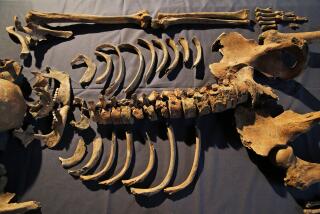THE BLACK DEATH AND THE TRANSFORMATION OF THE WEST.<i> By David Herlihy</i> .<i> Edited with an introduction by Samuel K. Cohn</i> .<i> Harvard University Press: 118 pp., $12</i>
- Share via
This slender volume sandwiches the text of three lectures delivered in 1985 by the renowned medievalist David Herlihy between an introduction prepared by his pupil, Samuel F. Cohn, and a set of notes in which both authors apparently had a hand. The result is an odd sort of palimpsest for Cohn, who is a formidable scholar in his own right and goes out of his way to emphasize defects in Herlihy’s arguments and the limitations of his erudition. Yet Cohn concludes: “No doubt the courageous interpretation and creative synthesis found in these three essays will stimulate other questions and objections, and it is in this that I see the principal merit of their posthumous publication.”
One wonders. Inviting others to disagree is, at best, a backhanded compliment to a revered scholar. Lectures that Herlihy consigned to his files perhaps should have rested there especially because as Cohn points out, Herlihy lived long enough to change his mind on some of the points made in “The Black Death and the Transformation of the West” and would surely not have published them in their present form, if at all.
All the same, in the last four pages of his second lecture, Herlihy proposes a grand speculative idea about the demographic impact on Western Europe as the bubonic plague emerged from rat-infested holds of cargo ships and spread throughout most of Europe. Herlihy’s suggestion seems very plausible to me, and this nugget perhaps justifies the publication of these otherwise undeveloped observations on the Black Death. From earliest medieval records, Herlihy posits, it appears that among the propertied classes “a linkage was forged between resources and nuptiality, resources and reproduction. What we do not know is whether these restraints affected the behavior of those who owned little or nothing.”
But enough hints survive, especially from detailed data from Florence, to persuade Herlihy that the division of medieval society into two tiers, the poor and the wealthy, survived after the ravages of the plague and that “[t]he great population debacle of the late Middle Ages did not, in sum, introduce an entirely new demographic system. But it did redistribute the population between the two tiers of the traditional system. . . . High wages and low rents raised the standard of living for substantial numbers. . . . For a significantly larger proportion of the population, the care of property and the defense of living standards were tightly joined with decisions to marry and reproduce. . . . Out of the havoc of plague, Europe adopted what can be called the modern Western mode of demographic behavior.”
If so, the Black Death set Europe on a path toward our modern preoccupation with ever-rising standards of living, for in Herlihy’s words: “Controlled population growth meant that increments in output were not immediately consumed in the support of a larger population. Early modern England escaped the Malthusian trap, which kept many nations of the earth on the margins of subsistence and in the grip of poverty. The surpluses that the economy might generate were available for other uses, wise or foolish. Surpluses, allowing for a high rate of reinvestment, were at all events a precondition for eventual industrialization.”
Herlihy derived his references to 16th century England from the path-breaking use of parish records by E.A. Wrigley and Roger Schofield in their famous book, “The Population History of England,” published in 1981. No one knows for certain whether other parts of Western Europe regulated population as rigorously as the English did after the mid-1500s by connecting marriage with access to sufficient land (or other income-producing capacity) to sustain a family. But demographers have reason to think that similar practices did extend to some parts of the continent, creating a distinctive “European” pattern of family formation whose implications for raising standards of living are obvious. But as far as I am aware, no one has previously suggested that the Black Death played a crucial role in establishing this pattern of family formation and population control.
As it stands, Herlihy’s speculation that the catastrophe of the Black Death may have triggered far-reaching restraints on population growth in Western Europe rests on slender data from the single city of Florence. It will take a generation of painstaking research to define more exactly when and where new patterns of marriage and family formation came into force, if in fact they did. We already know that not all Europeans shared the demographic behavior of increasingly commercialized England. Particularly among the Irish, early marriage sustained increasing numbers even in the face of bitter, perhaps increasing, poverty until 1845-47, when the sudden failure of the potato crop, upon which the Irish rural population had come to depend, which provoked disastrous famine. Famine losses (and emigration) almost reproduced the scale of die-off from the Black Death and the change in demographic behavior that ensued, whereby the rural Irish started to delay marriage rigorously until land became available for the newly married pair, duplicated the change Herlihy imputes to the Black Death.
The facts of Irish demography between the 18th and 20th centuries are well established and entirely unambiguous. There is no doubt that the terrible shock of the famine of 1845-47 altered marriage patterns, suddenly and decisively, operating, of course, along with innumerable other influences, not the least of which was the possibility of massive emigration and the strengthening influence of the Catholic Church at home.
Herlihy does not mention the Irish parallel in “The Black Death,” but it leaped to mind as I read his book and considerably reinforced the plausibility of his suggestion. Historical demographers can, almost certainly, find data to test Herlihy’s idea and begin to discern the times and places when marriage and the formation of families came to be based on economic expectations. If it can be definitely established that the disaster of the Black Death triggered this response among the more commercialized populations of Europe (which is what I would expect) and did not affect populations among whom subsistence modes of life prevailed, we will achieve a new and important understanding of how some Europeans reacted to the disaster of the 14th century and escaped the Malthusian trap into which the Chinese seem to have fallen ever since their extraordinary commercial and industrial expansion between the 11th and 13th centuries. Herlihy points the way: It remains to be seen whether appropriate researches will substantiate his idea and solidly ground our understanding of the role of the Black Death in shaping the demographic curve of European and world history in recent centuries.
But, alas, most of Herlihy’s other ideas and suggestions in “The Black Death” strike me as being of little value. Trying to connect the use of saints’ names for personal names with an altered religious consciousness arising out of the experience of the Black Death runs into a difficulty: apparent changes in naming in a few Italian cities antedated the plague by half a century and, as Cohn informs us, Herlihy later changed his mind on this point.
Even less persuasive is Herlihy’s suggestion that the Black Death was probably not caused by the plague bacillus identified in Hong Kong in 1894 and accepted as the carrier of the disease. He occasionally betrays an unhappy ignorance of epidemiology, as when he says, inexplicably, that different paths of entry into human bodies produce “three types of plague, though not all are due to the same bacillus.” Or when he declares: “Bubonic plague is today regarded as a tropical disease.” One can hope that had Herlihy decided to put these lectures into print, he would have changed his mind on these points after reading more widely in the appropriate literature.
A more general defect of Herlihy’s whole approach to his subject in this book is his assumption that by about 1300, Europe was “caught in a Malthusian deadlock, in a demographic and economic situation which paralyzed the capacity to improve the ways it produced its goods. That system, marked by saturated use of resources and stagnant outputs, might have persisted indefinitely. The plague broke the deadlock, and allowed Europeans to rebuild their demographic and economic systems in ways more admissive of further development.”
The plague may indeed have changed European demography and opened the path toward the extraordinary growth of wealth and power that ensued. I think it probably did have that effect. But the notion that a condition of stagnant stability had been achieved in Europe around the 1300s “that might have persisted indefinitely” contradicts all historical experience. When has change among human beings ceased to prevail? When did any civilized population cease to endure novelty, either increasing or declining in numbers, and either enjoying growth in wealth and power or suffering as its niche in the human and natural environment withered and shrank?
In our age of exploding population, demographers have commonly yearned for zero population growth. But populations, whether of humans, animals or any other life form, have never been stable and, I venture to say, never will be. Herlihy was, among his other skills, a notable historical demographer, and it looks as though he had transferred demographers’ fixation on a mythical stable state in the future to a particular phase of the European past--unthinkingly and absurdly. For if the plague had never happened, we can be sure that other surprising changes would have come along to alter the situation. Perhaps such a catalyst would have been less painful, or perhaps even more destructive, than what actually happened to the peoples of Europe after 1345 when the Black Death arrived among them so unexpectedly.


